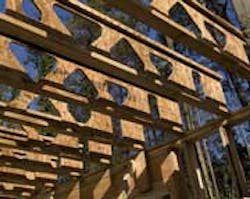Of the many issues affecting the Fire Service, the prevailing challenge that has a pronounced impact on operational safety is the assimilation of engineered structural systems (ESS) into mainstream building design and construction. The presence of engineered structural systems (ESS) are no longer considered to be an innocuous feature in a given building or occupancy; it is the predominate feature in nearly all current construction, renovation and adaptive reuse or infill applications. It has become far more than just concerning ourselves with the presence of a simple light-weight or “engineered” truss roof system or an I-beam wood floor assembly.
There is a new lexicon of building construction components and systems that must be added to your operational safety vocabulary and incident action plans. There is a new terminology, applications and a knowledge base to learn that will support operational excellence and support the integrity of incident safety performance of companies and personnel. Do you know what they represent and how these components, assemblies and systems may affect or influence an incident? Stability, integrity, compromise, collapse, failure, resistence, degradation or catastrophic impacts..there's alot to consider in the presence or absence of inherent "safety" margins.
The fire service continues to apply the term “light weight construction” to a wide variety of building construction and systems. This expression has become a miss-application of both term and the correlation of risk and severity related to operational profiling. In other words, we apply and express the use of “light weight construction” for all types of engineered components, systems, designs and assemblies in nearly all types of building construction and occupancy use. Although the roots of the term can be traced back to the early 1980’s, and its application to the (then) emerging use of trussed roofing systems and the advent of wood I-beam floor supports (sans solid dimensional lumber joists), the use of the terminology in today’s context of risk assessment, strategic and tactical management and deployment models and within the context of incident operational tactics is no longer applicable, valid or suitable. It must be expanded into a more specific and descriptive level of classification and correlation.
For the most part, when discussing buildings and occupancies, aside from classifications related to code type or class as an element of fire resistance; the emphasis has been to differentiate between conventional and engineered construction, and the application of the term “light weight construction”. I continue advocating and promoting, through my lectures that it’s much more than this when looking at the spectrum of construction and the structural anatomy of buildings. Current and past generations of buildings, construction and occupancies can be more accurately differentiated and classified within six (6) expanding categories in the following Building Construction Systems;
Here's a series of other important Reference Links that provide some insights on operational safety, incident conditions and factors and the lessons-learned from a number of LODD events;
NIOSH Publication No. 2009-114: Preventing Deaths and Injuries of Fire Fighters Working Above Fire-Damaged Floors HERENIOSH Publication No. 2005-132: Preventing Injuries and Deaths of Fire Fighters Due to Truss System Failures HEREVolunteer Deputy Fire Chief Dies after Falling Through Floor Hole in Residential Structure during Fire Attack—Indiana, HEREFirst-floor collapse during residential basement fire claims the life of two fire fighters (career and volunteer) and injures a career fire fighter captain - New York, Report HERECareer Fire Fighter Dies After Falling Through the Floor Fighting a Structure Fire at a Local Residence - Ohio, HEREColerain Township, Ohio Double LODD Preliminary Report, HERE Career engineer dies and fire fighter injured after falling through floor while conducting a primary search at a residential structure fire - Wisconsin, HERENFPA Report on Light Weight Construction, HEREInformative USFA Coffee Break series postings related to Building Types & Fire Resistance: HERE. HERE, HERE, HERE, and HERE
Remember,Building Knowledge = Firefighter Safety (Bk-F2S)





